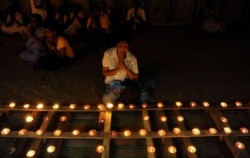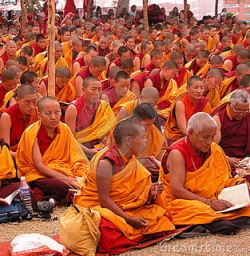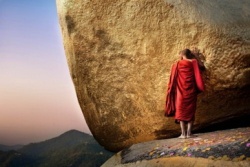Uttarakuru
Uttarakuru (Skt.; Tib. Draminyen; Wyl. sgra mi snyan; Eng. 'Unpleasant Sound') in the North, which is square and green
Uttarakuru is located in the north, and is shaped like a square. It has a perimter of 8,000 yojanas, being 2,000 yojanas on each side. This continents tree is called a kalpavrksa (Pali: kapparukkha) or kalpa tree, because it lasts for the entire kalpa. The inhabitants of Uttarakuru are said to be extraordinarily wealthy. They do not need to labor for a living, as their Food grows by itself, and they have no private property. They have cities built in the air. Uttarakuru (Sanskrit) is the name of a dvipa ("continent") in ancient Hindu and Buddhist mythology. The Uttarakuru country and its people are sometimes described as belonging to the real world, whereas at other times they are mythical or otherworldly spiritual beings.
Vedic literature
Aitareya Brahmana makes first reference to Uttarakuru and Uttaramadra as real-life Janapadas. According to Aitareya Brahmana , these two nations lied beyond the Himalayan ranges (Hindukush). The Aitareya Brahmana adduces these two people as examples of republican (vairajiya) nations, where whole Janapada took the consecration of rulership.
Aitareya Brahmana again notes that Uttarakuru was a devak-setra or divine land.
Puranas
In later literature like Puranas, the Uttarakurus are sometimes described as mythical people, while at other times their description seems to place them in the real world.
Puranic cosmography divides our earth into seven concentric islands called Jambu, Plaksha, Salmali, Kusha , Kraunca, Shaka, and Pushkara. They are separated by the seven encircling seas. The insular continent Jambudvipa forms the innermost concentric island in the scheme of continents. Jambudvipa includes nine countries (varṣa) and nine mountains. The land of Illa-vrta lies at the center of Jambudvipa at whose center is located Mount Meru. The land of Uttarakuru lies to the north of Mount Meru.
The land of Uttarakuru of the Puranas is said to be somewhat of an El Dorado. The Bhagavata Purana notes the Uttarakuru as the land of the "northern Kurus", a people separate from the Dakisha Kurus.
The Brahmanda Purana and [[Vayu Purana}} state that the Pururavas, the ancestors of the Puru race once lived with Urvasi in Uttarakuru.
In Matsya Purana, Uttarakuru is described as 'Tiratha', that is: a pure place where one went to undergo ritual ablutions.
Mahabharata
Mahabharata sometimes depicts the Uttarakuru as a fairy land. It is stated to be the ultimate abode of the blessed souls. The souls of the blessed ones and the glorious Kshatriyas who fall in battle go to Uttarakuru after death.
Adiparva of Mahabharata refers to a practice of free love among the denizens of Uttarakuru, like the one followed by birds and the beasts, and is not regarded sinful as it is stated to have the approval of the rishis and the sanction of antiquity. At other times, the epic describes the Uttarakurus as real entity and associates them with the real Kurus.
The ancestors of the Kauravas and Pandavas had originally migrated from Uttarakuru.
At the Rajasuya Sacrifice performed by king Yudhishtra, the kings of north-west brought gifts, some of which belonged to Uttarakuru.
After reducing the Kambojas and Daradas on south of Hindukush, Arjuna proceeded to Trans-Hindukush countries and fought with the Lohas, Parama-Kambojas and the Rishikas. Thereafter, Arjuna encountered the Kimpuruhas, Haratakas and the Uttarakurus, which were the neighboring tribes in the trans-Himalaya region.
Karna in practice of war started Vijayatra conquering whole Eurasia.
Ramayana
In the enumeration of the countries of north, Ramayana references Kambojas, Yavanas, Shakas, Paradas and then further northwards, it refers to the land of the Uttarakurus lying beyond river Shailoda and Kichaka bamboos valleys. It gives very vivid and graphic picture of Uttarakuru region.
Buddhist text
Uttarakuru also finds numerous references in Buddhist literature, sometimes as a real land and other times as a mythical region.
In Digha Nikaya, Uttarakuru is said to be the name of city.
Lalita-Vistara describes the Uttarakuru as Pratyanta-dvipa or a frontier island.
Sumangalavilasini says that the wife of a Chakravarti king comes either from Uttarakuru or from the race of a king Madra.
Buddhaghosa records a tradition which states that, when Vedic king Mandhata returned to Jambudvipa from his sojourn in the four Mahadipas, there were, in his retinue, a large number of the people of Uttarakuru. They all settled down in Jambudípa, and their settlement became known as Kururattha (Kuru Rashtra). Majjhima Commentary also attests that the people of Kururatha had originally belonged to the Uttarakuru.
Rajatarangini of Kalhana
According to Rajatarangini of Kalhana, king Lalitaditya Muktapida of Kashmir leads a war expedition against the tribes of north (i.e. north of Kashmir) and in sequence, encounters the Kambojas, Tusharas, Bhauttas, Daradas, Valukambudhis, Uttarakurus, Strirajya (mythical or otherwise) and Pragjyotisha with whom he fights one after the other.
Foreign sources
Ptolemy's Geography refers to Ottorokorai (Uttarakuru) tribe, Ottorokora as a city, and Ottorokoras as a river. The Ottorokora city is shown as located at longitude of 165° 37' 25" E. Ptolemy has also referred to one mountain by the same name and fixes at with longitude from 169° 39' to 176° 39' E.
The Attacori of Pliny probably also refers to the Uttarakuru people and their country.
Ammianus Marcellinus refers to Uttarakuru as Ottorogorae.
Geographical location
Though the later texts mix up the facts with the fancies on Uttarakurus, yet in the earlier, and some of the later texts, Uttarakurus indeed appear to be historical people. Hence scholars have attempted to identify the actual location of Uttarakuru.
Puranic accounts always locate the Uttarakuru varsa in the northern parts of Jambudvipa.
The Uttarakuru is taken by some as identical with the Kuru country mentioned in the Rig-Veda. The Kurus and Krivis (Panchala) are said to form the Vaikarana of Rigveda and the Vaikarana is often identified with Kashmir. Therefore, Dr Zimmer likes to identify the Vaikarana Kurus with the Uttarakurus and places them in Kashmir
Michael Witzel locates his Uttarakuru in Uttarakhand Pradesh.
According to some scholars, the above locations however do not seem to be correct since they go against Aitareya Brahmana evidence which clearly states that Uttarakuru and Uttaramadra lied beyond Himalaya ([[pren himvantam janapada Uttarakurva Uttaramadra). Moreover, no notice of the Uttaramadras (Bahlika, Bactria) has been taken of while fixing up the above location of Uttarakuru. Uttarakurus and Uttaramadras are stated to be immediate neighbors in the Trans-Himalaya region per Aitareya Brahmana evidence.
Ramayana testifies that the original home of the Kurus was in Bahli country. Ila, son of Parajapati Karddama was a king of Bahli, where Bahli represents Sanskrit Bahlika (Bactria). Also the kings from Aila lineage have been called Karddameyas. The Aila is also stated to be the lineage of the Kurus themselves. The Karddamas obtained their name from river Karddama in Persia/ancient Iran. Moreover, Sathapatha Brahmana attests a king named Bahlika Pratipeya as of the Kauravya lineage. Bahlika Pratipeya, as the name implies, was a prince of Bahlika (Bactria). Thus, the Bahli, Bahlika was the original home of the Kurus. Thus, Bahlika or Bactria may have constituted the Uttarakuru. Mahabharata and Sumangalavilasini also note that the people of Kuru had originally migrated from Uttarakuru. Bactria is evidently beyond the Hindukush i.e. Himalaya. In ancient literature, Himalaya is said to be extending from eastern occean to western occean and even today is not separated from it.
The above identification of Uttarakuru comes from Dr M. R. Singh.
K. P. Jayswal identifies Mt Meru of the Puranas with the Hindukush ranges and locates the Uttakuru in the Pamirs itself.
V. S. Aggarwala thinks that the Uttarakuru was located to north of Pamirs in Central Asia and was also famous for its horses of Tittirakalamasha variety. Thus it probably comprised parts of Kirgizstan and Tian-Shan. Incidentally, the reference to horses from Uttarakuru rules out any possibility of locating Uttarakurus in Kashmir and Uttarakhand Pradesh since these regions have never been noted for their horses.
Buddha Prakash locates the Uttarakuru-varsa in Sinkiang province of China.
Bhishamaparava of Mahabharata attests that the country of Uttarakuru lied to the north of Mt Meru and to the south of Nila Parvata
The Mt Meru of Hindu traditions is identified with the knot of Pamirs. Mountain Nila may have been the Altai-Mt.
The Mahabharata refers to the Kichaka bamboos growing on the banks of river Shailoda. Mahabharata further attests that the Kichaka bamboo region was situated between Mountain Meru (Pamirs) and Mountain Mandara (Alta Tag). The river valleys between these two mountains are still overgrown with forests of Kichaka Bamboos.
Ramayana also attests that the valleys of river Shailoda were overgrown with Kichhaka bamboos and the country of Uttarakuru lied beyond river Shailoda as well as the valleys of Kichaka bamboos.
River Shailoda of Ramayana and of Mahabharata has been variously identified with river Khotan, Yarkand, and Syr (Jaxartes) by different scholars.
Raghuvamsa also refers to the Kichaka bamboos of Central Asia in the eastern regions of the Pamirs or Meru mountains which were known as Dirghavenu in Sanskrit.
The above discussion shows that the land of Uttarakurus was located north of river Shailoda as well as of the Kichaka bamboo valley.
Rajatarangini places Uttarkuru land in the neighborhood of Strirajya. Based on Yuan Chwang's evidence, Strirajya is identified as a country lying north of Kashmir, south of Khotan and west of Tibet.
Thus, the Uttarakuru which finds reference in the Ramayana, Mahabharata and Rajatarangini probably can not be identified with the Bahlika or Bactria as M. R. Singh has concluded.
Uttarakuru probably comprised north-west of Sinkiang province of China and parts of the Tian-Shan.
Christian Lassen suggests that the Ottorokoroi of Ptolemy should be located in the east of Kashgar i.e. in Tarim Basin.
Some writers, however, assert that Uttarakuru was the name for the vast area lying north of Himalaya and extending as far as Arctic Circle.
Some people tend to identify the Uttarakurus and the Uttaramadras with the Tocharian (Uttarakuru = Tokhari) branch of Indo-Europeans, located to the north of the Himalayas
Tokhari or Tukharas, the later Yucchis, are the same as the Rishikas of Mahabharata.




